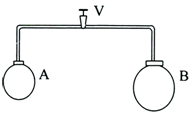A capillary is dipped in a water vessel kept on a freely falling lift. Then,

Important Questions on Surface Tension
Two spherical soap bubbles of radii and in vacuum coalesce under isothermal conditions. The resulting bubble has a radius such that,
Water rises to a height of in a glass capillary tube. If the area of cross-section of the tube is reduced to of the former value, the water rises to a height of,
Suppose $64$ raindrops combine to form a single drop. Calculate the ratio of the total surface energy of the $64$ drops to that of a single drop.
Two separate air bubbles (radii and formed of same liquid (Surface tension ) come together to form a double bubble. Find the radius of curvature in of the internal film surface common to both the bubbles.
Two soap bubbles and are kept in a closed chamber where the air is maintained at pressure The radii of bubbles and are and respectively. Surface tension of the soap water used to make bubbles is Find the ratio where and are the no. of moles of air in bubbles A and B, respectively [Neglect effect of gravity]
The valve in the bent tube is initially kept closed. Two soap bubbles A(smaller) and B(larger) are formed at 2 open ends of the tube. is now opened, and air can flow freely between the bubbles.

Two parallel glass plates are held vertically at a small separation d and dipped in a liquid of surface tension the angle of contact and density . The height of water that climbs up in the gap between glass plates is given by
Two capillary tubes of same radius are lowered into a vessel with water as shown. The water in the straight tube rises to a height 'h'. The lower end of bent tube is at a depth 'H' below the level of the water in the vessel. What will the level of water be in bent tube and what form will the meniscus take? The incorrect option for the given situation is

